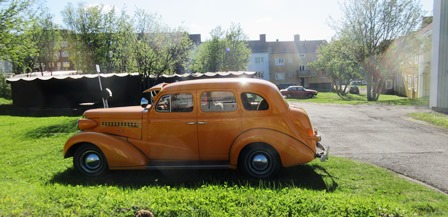Summer in Kiruna is like no other. To start with, it comes later than you can imagine. When everywhere else has already become a bit tired of warm sunny days, Kiruna still has snow. Then when it comes, it bursts at you, the rivers overspilling their banks and the greenery growing as you watch it. Twenty four hours of daylight takes some getting used to, and the days have no boundaries. Anything goes.
The weather is unreliable, in terms of a summer. It can be hot, but it’s always changeable. The temperature dropped from 26 degrees to 3 degrees in one day this week. After a blaze of glory a more common summer drizzle is now feeding the greenery and insects. Birds arrived early in anticipation of the richness of growth that comes from constant daylight and now they get their reward. A Kiruna summer has a certain style, a different edge to further south in Sweden. For one thing, we’re not very big on midsummer. For one thing, at that time summer has barely arrived. The national 19th century revival of Swedish folk traditions at midsummer – maypoles and garlands, dancing and folksy regional costumes, and white wine drunk from fine cut glass – aren’t a big feature here. Instead we have more local traditions – like cruising round town in your classic American or vintage car.

I know it doesn’t sound very local, the American car, but Kiruna youth have made it their own. Over the winter months yards all over town conceal a few old cars under a blanket of snow which in the spring emerge, each one like an exotic butterfly from a chrysalis, their brightly coloured paintwork and chrome polished to gleaming before taking to the road. A car full of people is the ideal, and usually driven late in the day, which means all night here. It’s so much a tradition there’s even a local club for it – ‘The Midnight Sun Cruisers’. Going nowhere in particular, just taking the air, windows down, music playing, engine roaring. Up and down. That’s summer.

The view from a car window isn’t pretty. Kiruna is a bit of an ugly duckling at this time of year. Debris and building waste, well hidden over the winter months, is revealed in all its glory (given the few months every year without snow the incentive to tidy them up isn’t great). The local council makes a bit of an effort, cutting some grass and putting out a few flower pots, but it doesn’t really make up for the general feeling of town, which is basically ‘industrial wasteland with mountain views’. Most people don’t care or even notice. We are a colour-deprived people all winter, in a landscape of white and grey, so when the snow goes we are overjoyed by colour, our eye settling on this to the exclusion of all else.
The sound of summer – the roar of the classic car, music fading in the air that’s chasing its blaring exhaust – is also the louder and more persistent roar of ‘triangle’ cars crawling up the hill. A large red triangle means ‘child at the wheel’. Well, maybe not child, but 14 year old anyway. Unbelievably it’s allowed here, on the grounds that teenagers were always allowed to drive farm vehicles, so if they pimp their parents’ old cars – or even their new cars – to a different engine strength and display the triangle, they’re allowed to drive them anywhere. And they do – constantly, up and down. Again, mainly through the night, like the classic car cruising, going nowhere in particular, for no particular purpose.
That’s really the joy of a summer in Kiruna. No particular place to go.

